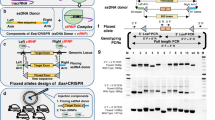Abstract
Gene targeting is extensively used to generate designer mouse mutants and to study gene function in vivo. Knockout mice that harbor a null allele in their germline provide appropriate genetic models of inherited diseases and often exhibit embryonic or early postnatal lethality. To study gene function in adult mice and in selected cell types, a refined strategy for conditional gene inactivation has been developed that relies on the DNA recombinase Cre and its recognition (loxP) sites. This process has traditionally relied on the complex process involving genome editing in embryonic stem (ES) cells despite its limitations, including incorrect targeting or cassette structure, and difficulties with germline transmission of the allele from chimeric mice. CRISPR-Cas9 gene editing technology has considerably facilitated the generation of mouse knockout alleles, relieving many of the cumbersome and time-consuming steps of traditional mouse ES cell technology. However, the generation of conditional knockout alleles remains an important challenge. An earlier study reported up to 16% efficiency in generating conditional knockout alleles in mice using 2 single guide RNAs (sgRNA) and 2 single-stranded oligonucleotides (ssODN), which has been questioned by another report combining data from multiple transgenic cores. With the advent of CRISPR/Cas9 as a mouse genome modification tool, we assessed the efficiency of using this method in creating conditional targeted alleles in three genes, phosphatase and actin regulator 1 (Phactr1), apolipoprotein A-I (ApoA1), and actin-related protein T2 (Actrt2). Even though overall success rate was low—about 2.5%—we show that it’s possible to reliably generate conditional knockout alleles using CRISPR/Cas9 on a consistent basis.


Similar content being viewed by others
REFERENCES
Gu, H., Marth, J.D., Orban, P.C., Mossmann, H., and Rajewsky, K., Deletion of a DNA polymerase beta gene segment in T cells using cell type-specific gene targeting, Science, 1994, vol. 265, pp. 103–106.
Rajewsky, K., Gu, H., Kuhn, R., Betz, U.A., Muller, W., Roes, J., and Schwenk, F., Conditional gene targeting, J. Clin. Invest., 1996, vol. 98, pp. 600–603.
Sauer, B. and Henderson, N., Site-specific DNA recombination in mammalian cells by the Cre recombinase of bacteriophage P, Proc. Natl. Acad. Sci. U. S. A., 1988, vol. 85, pp. 5166–5170.
Hoess, R.H. and Abremski, K., Interaction of the bacteriophage P1 recombinase Cre with the recombining site loxP, Proc. Natl. Acad. Sci. U. S. A., 1984, vol. 81, pp. 1026–1029.
Brand,a, C.S. and Dymecki, S.M., Talking about a revolution: the impact of site-specific recombinases on genetic analyses in mice, Dev. Cell, 2004, vol. 6, pp. 7–28.
Jinek, M., et al., A programmable dual-RNA-guided DNA endonuclease in adaptive bacterial immunity, Science, 2012, vol. 337, pp. 816–821.
Cho, S.W., Kim, S., Kim, J.M., and Kim, J.S., Targeted genome engineering in human cells with the Cas9 RNA-guided endonuclease, Nat. Biotechnol., 2013, vol. 31, pp. 230–232.
Cong, L., et al., Multiplex genome engineering using CRISPR/Cas systems, Science, 2013, vol. 339, pp. 819–823.
Jinek, M., et al., RNA-programmed genome editing in human cells, Elife, 2013, vol. 2. e00471. https://doi.org/10.7554/eLife.00471
Mali, P. et al. RNA-guided human genome engineering via Cas9, Science, 2013, vol. 339, pp. 823–826.
Mashiko, D. et al. Generation of mutant mice by pronuclear injection of circular plasmid expressing Cas9 and single guided RNA, Sci. Rep., 2013, vol. 3355, no. 3. https://doi.org/10.1038/srep03355
Shen, B. et al. Generation of gene-modified mice via Cas9/RNA-mediated gene targeting, Cell Res., 2013, vol. 23, pp. 720–723.
Wang, H. et al. One-step generation of mice carrying mutations in multiple genes by CRISPR/Cas-mediated genome engineering, Cell, 2013, vol. 153, pp. 910–918.
Yang, H., et al. One-step generation of mice carrying reporter and conditional alleles by CRISPR/Cas-mediated genome engineering, Cell, 2013, vol. 154, no. 6, pp. 1370–1379.
Gurumurthy, C., et al. Re-evaluating one-step generation of mice carrying conditional alleles by CRISPR-Cas9-mediated genome editing technology, bioRxiv, 2018, vol. 393231. https://doi.org/10.1101/393231
Behringer R., et al., Manipulating the Mouse Embryo: A Laboratory Manual, Cold Spring Harbor, New York: Cold Spring Harbor Laboratory Press, 2014.
Horii, T., et al., Efficient generation of conditional knockout mice via sequential introduction of lox sites, Sci Rep., 2017, vol. 7, no. 1, p. 7891.
Bishop, K.A., et al., CRISPR/Cas9-mediated insertion of loxP sites in the mouse dock7 gene provides an effective alternative to use of targeted embryonic stem cells, G3 (Bethesda), 2016, vol. 6, no. 7, pp. 2051–2061.
Kueh, A.J., et al., An update on using CRISPR/Cas9 in the one-cell stage mouse embryo for generating complex mutant alleles, Cell Death Differ., 2017, vol. 24, no. 10, pp. 1821–1822.
Lanza, D.G., et al., Comparative analysis of single-stranded DNA donors to generate conditional null mouse alleles, BMC Biol., 2018, vol. 16, no. 1, p. 69.
Pritchard, C.E.J., Kroese, L.J., and Huijbers, I.J., Direct Generation of Conditional Alleles Using CRISPR/ Cas9 in Mouse Zygotes. Methods Mol Biol., 2017, vol. 1642, pp. 21–35.
Miyasaka, Y., et al., CLICK: one-step generation of conditional knockout mice, BMC Genomics, 2018, vol. 19, no. 1, p. 318.
ACKNOWLEDGMENTS
We would like to thank Dr. Christopher Lemke and Dr. Nicola van der Walt of CRISPR Core Partnership Program (Sigma Millipore/Merck KGaA, Darmstadt, Germany) for help with design and validation of CRISPR/cas9 materials.
Funding
This work was supported by Texas AgriLife Research (SS).
Author information
Authors and Affiliations
Corresponding author
Ethics declarations
The authors declare no conflict of interest or financial disclosure statements. This article does not contain any studies involving animals or human participants performed by any of the authors.
About this article
Cite this article
Golovko, A., Adams, J., Guo, H. et al. Consistent Production of Mice with Conditional Knockout Alleles by CRISPR/Cas9-Mediated Genome Editing Using Two Guides/Two Oligos Approach. Cytol. Genet. 54, 63–70 (2020). https://doi.org/10.3103/S0095452720010065
Received:
Revised:
Accepted:
Published:
Issue Date:
DOI: https://doi.org/10.3103/S0095452720010065




